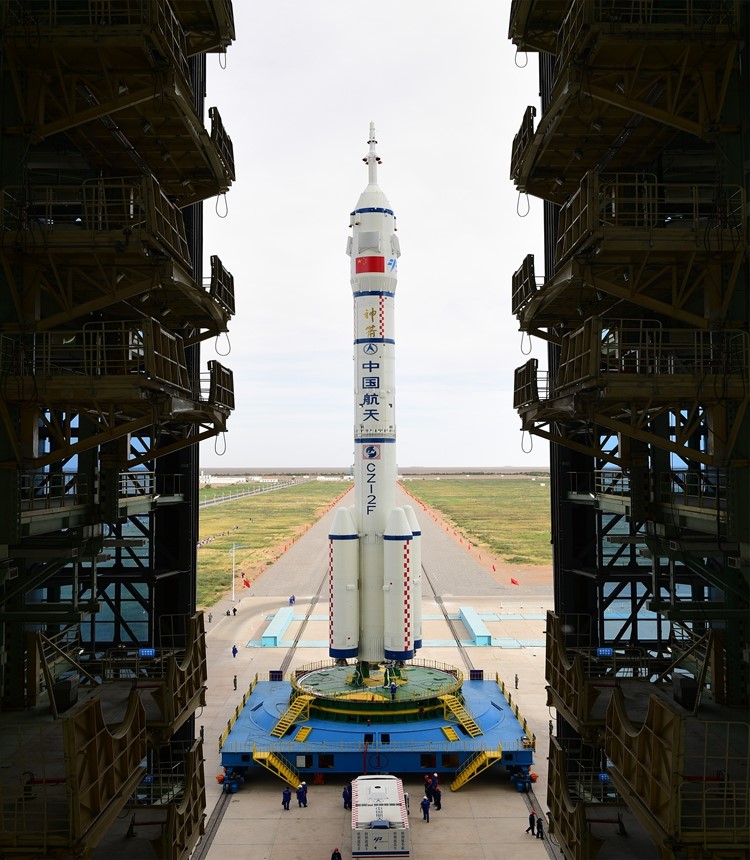China’s space station Tiangong to greet first batch of astronauts in June
 |
| Photo shows China’s Long March-2F Y12 carrier rocket. (Our Space/Wang Jiangbo) |
The combination of China’s Shenzhou-12 manned spaceship and a Long March-2F Y12 carrier rocket was transferred to the launching area of Jiuquan Satellite Launch Center in northwest China on June 9, 2021 Beijing time.
According to the China Manned Space Engineering Office (CMSEO), the facilities and equipment at the launch site are all in good condition, and that subsequent pre-launch function checks and joint tests will be carried out as planned, which means China’s space station Tiangong will meet its first batch of astronauts before long.
Hao Chun, director of the CMSEO, told media in a previous interview that according to plans for the first three missions in the construction of China’s space station, the country would transport support materials, necessary spare parts and equipment first, and then crew.
The country would first sent Tianhe into space, which is the core module the Tiangong space station, according to Hao, who disclosed that Tianhe will function as the space station’s control hub and energy provider, among other roles.
After the launch of the core module, China would launch a cargo spacecraft to deliver supplies for astronauts and space-science equipment, and then launch a manned spaceship to send astronauts into the space station for the verification of key technologies and other tasks, Hao said, adding that the same pattern will be followed in subsequent missions.
So far, the core module Tianhe and the cargo spacecraft Tianzhou-2 have been successfully launched and docked. According to relevant schedule, the Shenzhou-12 manned spaceship with 3 astronauts will be sent into space in June.
The crews participating in the construction of the space station face heavy tasks and higher requirements, according to Hao, who disclosed that the first 11 astronauts sent by the country into space have conducted 14 space flights in orbit and accumulated a lot of experience.
At present, China’s four spaceship crews undertaking relevant missions for the construction of the space station are trained simultaneously as planned, Hao said, noting that the crew of the Shenzhou-12 manned spaceship have finished most of their training activities and are about to enter a stage of intensive training for their tasks.
The fundamental part of China’s space station Tiangong consists of the core module Tianhe and two lab capsules named Wentian and Mengtian, respectively, according to Zhu Guangchen, deputy chief designer of the Tiangong space station from China Academy of Space Technology (CAST).
The core module and lab capsules were carried into space by the country’s Long March-5B Y2 carrier rocket in three separate launches and will complete in-orbit assembly and construction through space rendezvous and docking as well as transposition, Zhu said, noting that the space station Tiangong can accommodate three astronauts for long-term stay in normal circumstances and up to six during a crew replacement, and is able to support manned space science experiments, medical experiments, and tests on new technologies.
According to Zhu, the Tianhe core module of the space station is 16.6 meters in length, with its maximum diameter being 4.2 meters. Its sealed cabin has an astronaut activity space three times the size of China’s space lab Tiangong-2, and is equipped with three separate bedrooms and a washroom to ensure the daily life of astronauts. The dining zone has equipment to heat or refrigerate food, and supply drinking water, as well as a retractable dining table. Besides, with a space treadmill and a space bike in the exercise zone, astronauts can also take exercises in the space station.
In an effort to provide a convenient and comfortable living and working environment for astronauts, a scene-based lighting system and Wi-Fi technology have been adopted to help astronauts control cabin lighting and check the inventory in the station easily. Thanks to space-Earth communication links and devices for two-way video calls, astronauts will also be able to make and answer video calls and send and receive e-mails in the space station.
China’s space station construction project is implemented in two phases for verification of key technologies and in-orbit construction. A total of 12 space flight missions have been planned for the project, which is scheduled to be completed around 2022.
The main purpose of the stage for verification of key technologies is to conduct space science experiments and tests on technologies to lay a foundation for the construction and operation of the space station, according to Ji Qiming, an assistant to the director of the CMSEO.
The key technologies to be verified involve such aspects as long-term stay of astronauts in orbit, the Bioregenerative Life Support System (BLSS), replenishment of goods and materials in space, extravehicular activities, flexible solar cell wings, mechanical arm, flexible solar wings, control of large-scale flexible complex, in-orbit maintenance, as well as extravehicular operations, Ji said.
After the verification of key technologies, the country will start the in-orbit assembly and construction of its space station and eventually complete the construction of its national laboratory in space, Ji said, adding that upon completion, the space station will enter a stage of application and development that is expected to last for more than ten years.
Space is the common wealth of mankind, and aerospace is the common cause of all countries, Hao pointed out, adding that nine international scientific experiments involving 17 countries have been accepted to be conducted on board the upcoming Chinese space station.
In the future, China intends to innovate the model of its cooperation with other countries in aerospace, and encourage the participation of governments, institutions, businesses, and other parties, according to Hao. Through international cooperation, the country hopes to develop its space station into a platform on which all can conduct research for the benefit of the whole humanity.
It is believed that foreign astronauts will participate in China’s space missions, and work and live in the Chinese space station. Some foreign astronauts have already started to learn Chinese for taking part in China’s space missions, he noted.
While advancing the construction of the space station, China will carry out the selection of foreign astronauts and joint flight missions at the proper time, Hao said.
 |
Photos
Related Stories
- Astronauts will enjoy comfort, elbow room in China's space station
- Intl use of China Space Station to bring scientific benefits to world: UN official
- China's space station to surpass ISS in parts of technology: expert
- China’s space station expected to reach out-of-this-world standard
- Shenzhou XI astronauts enter Tiangong II space lab
- China to conduct brain-computer interaction experiments on Tiangong-2
- Tiangong-2 takes China one step closer to space station
- UN members permitted to use China's manned space station
- China's 1st space lab Tiangong-1 ends data service
- China to conduct more than 20 satellite launches in 2016
Copyright © 2021 People's Daily Online. All Rights Reserved.










